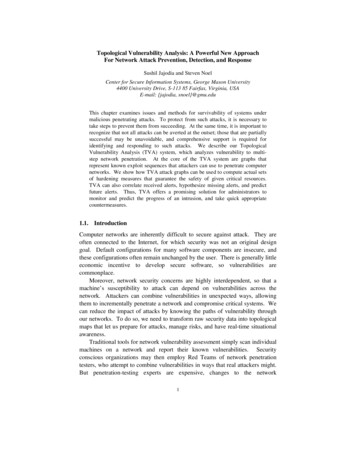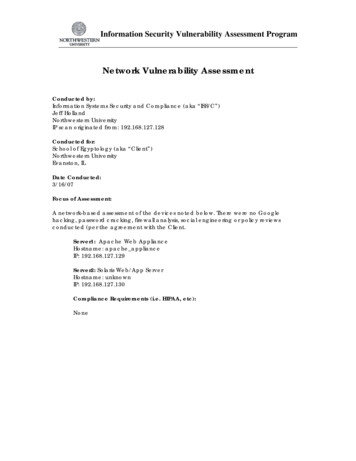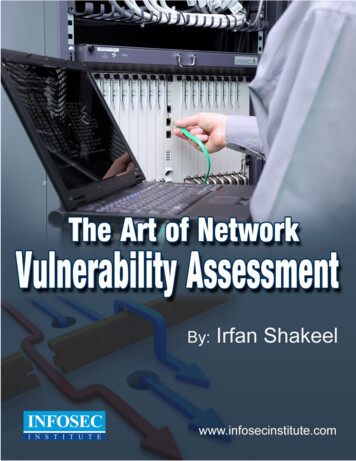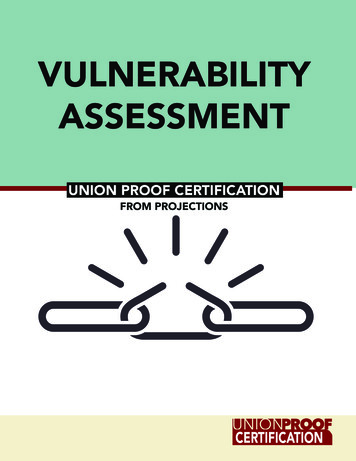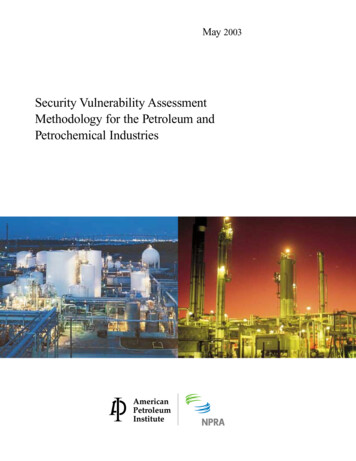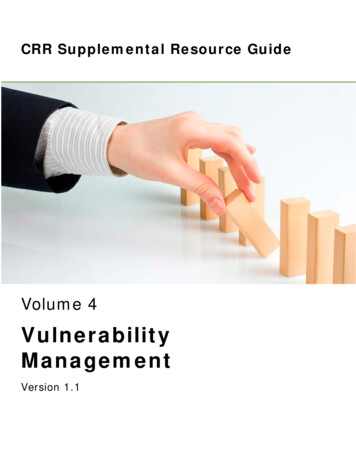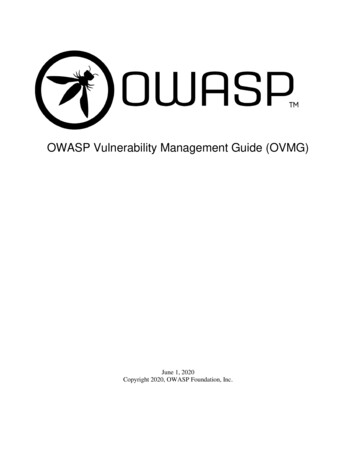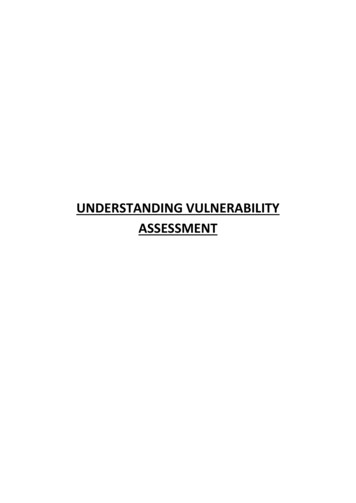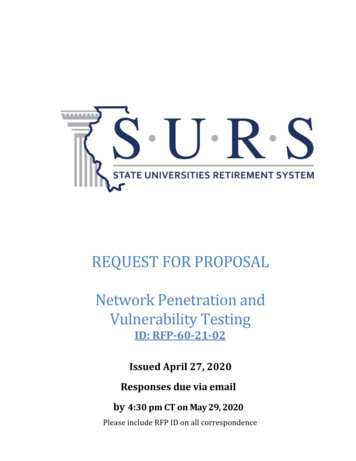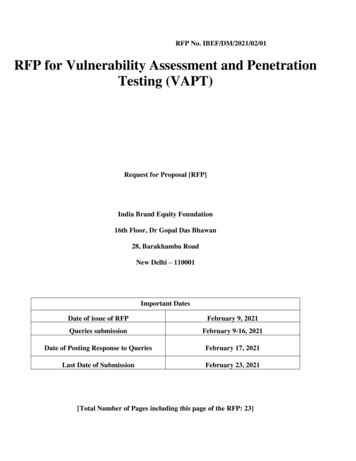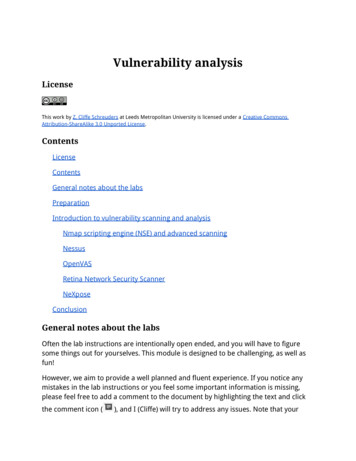
Transcription
Vulnerability analysisLicenseThis work by Z. Cliffe Schreuders at Leeds Metropolitan University is licensed under a Creative CommonsAttribution-ShareAlike 3.0 Unported License.ContentsLicenseContentsGeneral notes about the labsPreparationIntroduction to vulnerability scanning and analysisNmap scripting engine (NSE) and advanced scanningNessusOpenVASRetina Network Security ScannerNeXposeConclusionGeneral notes about the labsOften the lab instructions are intentionally open ended, and you will have to figuresome things out for yourselves. This module is designed to be challenging, as well asfun!However, we aim to provide a well planned and fluent experience. If you notice anymistakes in the lab instructions or you feel some important information is missing,please feel free to add a comment to the document by highlighting the text and clickthe comment icon (), and I (Cliffe) will try to address any issues. Note that your
comments are public.If you notice others are also reading the lab document, you can click the chat icon (to discuss the lab with each other.PreparationAs with all of the labs in this module, start by loading the latest version of the LinuxZtemplate from the IMS system. If you have access to this lab sheet, you can readahead while you wait for the image to load.To load the image: press F12 during startup (on the blue boot screen) to accessthe IMS system, then login to IMS using your university password. Load thetemplate image: LinuxZ.Once your LinuxZ image has loaded, log in using the username and passwordallocated to you by your tutor.The root password -- which should NOT be used to log in graphically -- is“tiaspbiqe2r” (this is a secure password but is quite easy 2 remember). Again, neverlog in to the desktop environment using the root account -- that is bad practice, andshould always be avoided.Using the VM download script (as described in the previous lab), download and startthese VMs: Kali Linux - with Armitage and Nessus (Bridged and Host Only) Vulnerable Win2K server (Host Only) Metasploitable (Host Only)Feel free to read ahead while the VMs are downloading.Note the IP address of the Kali Linux system, using “ifconfig”. Ensure that the VMs arenetworked as indicated above: that is, all share a “host only” network, and the KaliLinux VM also has a “bridged” network.Introduction to vulnerability scanning and analysisIdentifying vulnerabilities via ethical hacking and penetration testing requires carefulresearch and planning, and testing the exploits against vulnerabilities typically resultsin a compromise of the remote system. The advantage of a penetration test (hiringethical hackers to test security by hacking) is that there are very few false positives)
(that is, vulnerabilities “discovered” that are false alarms), since the security tester canactually attempt exploits and report whether they were successful.However, there is always a risk that an exploit may cause unintentional damage, orthat the ethical hacker will miss something obvious when they are checking thingsmanually.An alternative, shallower and automated approach, is to use vulnerability scanning(also known as vulnerability analysis or vulnerability assessment). Vulnerabilityscanners typically start by performing (or importing) network scans such as port scansand service identification, then automatically checks whether each of the identifiedservices are known to contain vulnerabilities.The way the security tests are conducted are often simply by comparing the serviceversion that has been detected with the versions known to have vulnerabilities (similarto what you did manually using Security Focus). Vulnerability scanners will oftenalso probe the software further to confirm that the system really does appear to bevulnerable. Some probes can potentially cause crashes, so a safe-mode is typicallyoffered to avoid the more dangerous checks.There are lots of different vulnerability scanners on the market, many of which areextremely expensive for commercial use (although arguably a necessity for efficientsecurity testing). No-cost evaluation versions are often available for home use.Nmap scripting engine (NSE) and advanced scanningThe Nmap scanner has a powerful feature known as the Nmap scripting engine (NSE).In addition to the scanning features that are built into Nmap, Nmap can be extendedwith scripts that add other capabilities. Nmap is distributed with a number of scripts(developed by various people), and these add more types of version detection andeven does some vulnerability detection.On the host OS (LinuxZ):Enable VMware player VMs to put the NIC into promiscuous mode. From the host OS(the LinuxZ image) run the following in a console (such as Konsole from KDEMenu System Terminal Konsole):sudo chmod a rw /dev/vmnet*On the Kali Linux (security tester) VM:Look at the list of files contained in:
/usr/share/nmap/scripts/For example, “ls /usr/share/nmap/scripts/”, or browse using a filebrowser, such as Dolphin.View the contents of “http-iis-webdav-vuln.nse”. Hint: consider using vi.This script is written in the Lua programming language, and it checks for a specificWebDav vulnerability.Open the Nmap man page, and read the description under the heading “NMAPSCRIPTING ENGINE (NSE)”. Note that “-sC Performs a script scan using the default setof scripts. [.] Some of the scripts in this category are considered intrusive and shouldnot be run against a target network without permission. ”Launch an Nmap scan using the default set of scripts (where IP address is theMetaploitable VM):nmap -sC IP-addressLaunch an Nmap scan using vulnerability scanning scripts (where IP address is theMetaploitable VM):nmap --script vuln IP-addressNote this can take a long time to complete (roughly 10 minutes); you may wishto leave this running and continue on with other tasks while it runs.When this completes read through the output. What vulnerabilities did itdetect?Nmap scripts have a lot of potential; however, the current set of scripts only check fora limited number of vulnerabilities.Based on what you have learned:1. Use the man page to answer: what does the -A Nmap flag do?Run an Nmap vulnerability scan against the Win2k server VM.Extra challenge: exploit a vulnerability detected by the Nmap script scan.Nessus
Nessus, by Tenable Network Security, is one of the most popular commercialvulnerability scanners. Vulnerability tests are written using NASL (the Nessus AttackScripting Language), and subscriptions to “feeds” of vulnerability checks are available.The “HomeFeed” is available for noncommercial home and educational use forno cost, while the “ProfessionalFeed” receives updates sooner and can be used incommercial settings.Nessus is based on a client/server architecture, where a client (such as the webinterface) connects to the server, which does the scanning. Results can be importedinto Metasploit.In addition to vulnerability scanning, Nessus can be used for compliance checks (suchas checking the security policies on networked systems by giving Nessus credentials tomanage them).Open a terminal, and run:service nessusd startStart Iceweasel, and visit:https://localhost:8834Confirm the security exception. (“I Understand the Risks”, “Add Exception”.) Thewarning is shown because the site is secured using a self-signed certificate.Login with username: “nessusadmin”, password: “toor”.Note that there are various scanning profiles available, and depending on yourselection Nessus will check the target(s) for different types of security issues.Click on “Policies”, and review the various scan types that are preconfigured. Click on“External Network Scan”, and browse the Plugins that are enabled for this profile.Lets use Nessus to scan Metasploitable for vulnerabilities:Click “Scan Queue”.The Nessus Scan QueueClick “New Scan”.
Configure a scan, by entering a name for the scan, such as “MetasploitableScan”, and enter the IP address of the system you wish to perform avulnerability scan of. In this case the IP address of the Metasploitable VM. Notethat you could instead enter an IP address range.Adding and starting a new scanClick “Run Scan”, to run a vulnerability scan against the Metasploitable target VM.Click “Results”. You will see that the vulnerability analysis scan is currently running.Nessus scan in progressClick the ongoing scan (in this case “Metasploitable Scan”), and view the progress. TheNessus scan is quite detailed, and will take some time to complete.
Nessus scan in progress, some vulnerabilitiesClick “Vulnerabilities”, to view the security vulnerabilities that have been detected.Browsing the detected vulnerabilitiesBrowse through the list of detected vulnerabilities (if there are not any yet, just wait awhile), and click on one of the issues to view more detailed information.Vulnerability details
Read through the information for the vulnerability and answer the following: What is the CVE for this vulnerability? Are exploits available? What kind? (Stand alone, MSF, etc) What would be the likely result of an attack on this vulnerability? How would you fix this issue?Once the scan is complete:How many vulnerabilities did it detect? How many of the vulnerabilities did you miss when you have previouslyscanned these systems using Nmap, MSF, and Armitage? How many vulnerabilities that were detected are “critical”, “high”, and so on?(Make a note of the number of vulnerabilities)Click “Export Results”, and generate various HTML reports. View the output of thesereports.Generating Nessus reportsWhat information from these reports do you think a you would use: During a penetration test? When writing a report for the management of a company that hired you to testtheir systems?
When writing a report for the IT department of the company?Extra challenge: save and import the results into MSF.Exploit a vulnerability detected by the Nessus vulnerability scan, to confirm thesystem is vulnerable.OPTIONAL TASK: run a scan against the Win2k VM.OpenVASNessus was originally free and open source software (FOSS); however, in 2005they closed the source code and removed the permission to use the software forcommercial use without a paying for a license. In response to this, the communityforked the last version of Nessus that had been released as FOSS, and started theOpenVAS (Open Vulnerability Assessment System) project, a free product. Due toa smaller developer team, OpenVAS’s database of vulnerability checks may be lesscomplete. As with Nessus, results can be imported into Metasploit.OPTIONAL TASK: Comparison with OpenVASNote that using OpenVAS on Kail Linux may involve some troubleshooting to get itworking. Consider this an open-ended optional task. If you identify any steps that aremissing, please leave a comment.Setup OpenVAS on Kali Linux:If you are in the Leeds Met IMS labs, run:export http proxy 192.168.208.51:3128openvas-setupThis will take quite some time, to download and install all the plugins.Note that the default account is named “admin”, and you will set apassword while the above runs.Once the install is complete:openvas-startOpen another Iceweasel tab, and visit:https://localhost:9392
Confirm the security exception.Login with username: “admin”, password: (as you have configured it).Run a vulnerability scan against the Metasploitable target VM, using the mostcomplete scanning profile that you think is appropriate.Tip: if you need a guide, try this tutorial.How many critical vulnerabilities did it detect? How does this compare with the earlierNessus scan? What are the differences?Retina Network Security ScannerRetina, was developed by eEye Digital Security and acquired by BeyondTrust, and issimilar in purpose to Nessus. It scans a network or host, and produces a report on thevulnerabilities it discovers. Includes some integration with Metasploit.OPTIONAL TASK: download a trial version, install, setup, and run Retina NetworkSecurity Scanner. Run a vulnerability scan against the Metasploitable target VM, usingthe most complete scanning profile that you think is appropriate.How many critical vulnerabilities did it detect? How does this compare with theearlier scans? What are the differences?NeXposeNeXpose is developed by Rapid7, who also now manage the Metasploit project. Again,the purpose of NeXpose is similar to the above, although due to the relationship, thereis extensive integration with Metasploit to pen-test detected vulnerabilities.OPTIONAL TASK: download a trial version, install, setup, and run NeXpose. Run avulnerability scan against the Metasploitable target VM, using the most completescanning profile that you think is appropriate.How many critical vulnerabilities did it detect? How does this compare with theearlier scans? What are the differences?Web vulnerability analysisIn addition to tests to look for vulnerable software running as remote services (andcompliance checks regarding client system configuration), security testers often haveto test the security of web servers. While the above vulnerability scanners will dosome testing of web servers that are detected, there are also a number of vulnerability
scanners that exclusively scan web servers for software and misconfigurationvulnerabilities.Nikto is a command line web vulnerability scanner. Nikto scans for over 6000 securityissues, such as dangerous CGI scripts and permissions.Use Nikto to scan the Metasploitable VM, then the Win2k VM.nikto -host Target-IP-AddressTake some time to read and understand the output. How many critical vulnerabilities did Nikto detect? Did it detect any that the above scanners missed?Based on one of the detected vulnerabilities: Can you identify the CVE for the vulnerability? How could you exploit this vulnerability? (With what attack software/exploit?) What would be the likely result of an attack on this vulnerability? How would you fix this issue?Exploit a vulnerability detected by the Nikto vulnerability scan, to confirm the system isvulnerable.ConclusionAt this point you have: Learned about vulnerability assessment Run vulnerability scans using various industry standard tools, including Nessusand Nikto Understood that different tools will detect different security issues, and that it isimportant to consider which tests (and scan profiles) to runWell done.
Introduction to vulnerability scanning and analysis Nmap scripting engine (NSE) and advanced scanning Nessus OpenVAS Retina Network Security Scanner NeXpose Conclusion General notes about the labs Often the lab instruct
